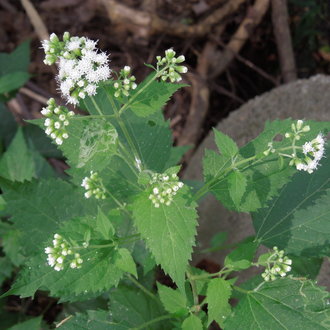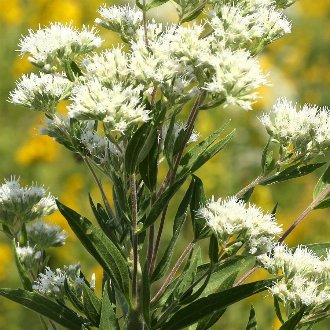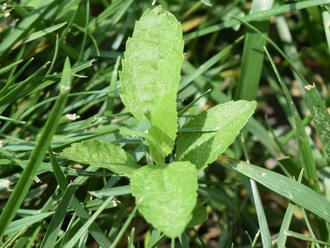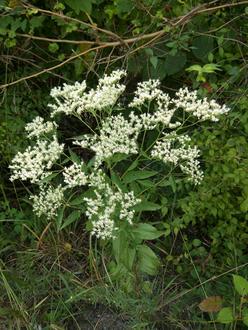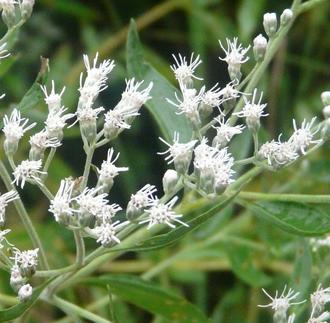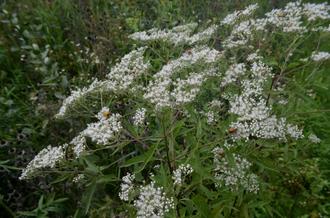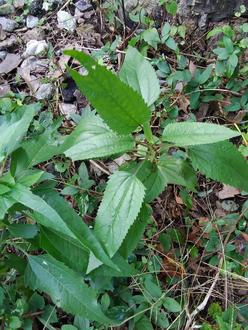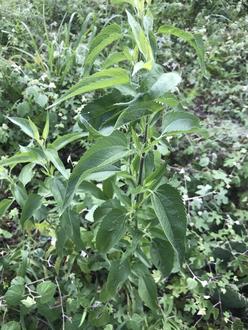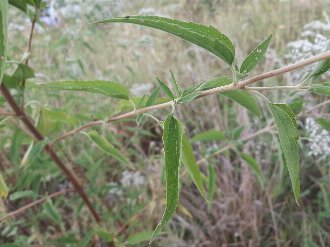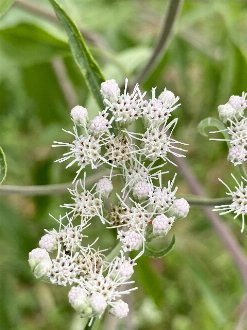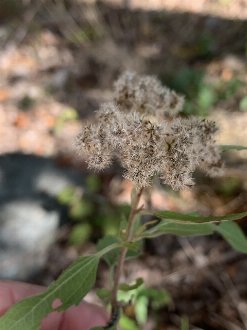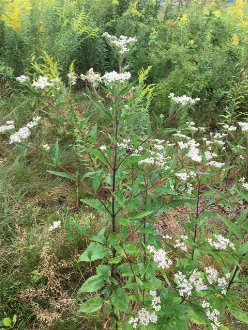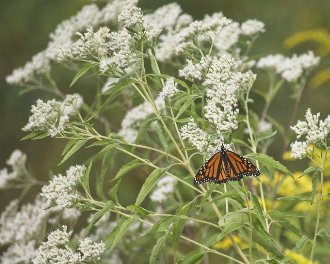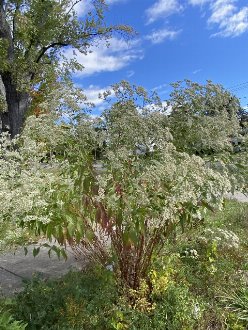Late Boneset (Eupatorium serotinum Michx.)
Also known as late thoroughwort, lateflowering thoroughwort.
↑Summary
A perennial of sunny, disturbed, moist areas, native to the southeastern to central US, expanding into the northeast.
↑Range - Expand
| Legend | Color |
| Native | |
| Expanded | |
| Native or Expanded | |
| Expanded or Not Present | |
| Native or Not Present |
This map is based on our research. We have checked its accuracy to Level 3 ecoregions. Although this plant occurs somewhere in each of these regions, it may only occur in a small part of some or all of them.
This species has wind-dispersed seeds and thrives in disturbed habitats, including along roads and railroads. It is not widely planted in gardens. It is expanding its range, particularly in the northeast, but also expanding northward somewhat in the Midwest. It has already expanded much beyond the range reported by USDA and BONAP.
↑Similar Plants
↑Habitat
Found in a wide variety of recently-disturbed, sunny to partly-sunny areas, usually in mesic to moist conditions. Habitats include sunny opening in floodplains and swamps, moist black soil prairies, wet ditches along roadsides and railroads, and wet portions of abandoned fields or overgrazed pastures.
Prefers loamy soil rich in organic matter, but tolerates sandy soil on sufficiently moist sites, especially along streams, and also tolerates clay soil. Less tolerant of thin, rocky, or gravely soil.
Although this species is most common on moist bottomland sites, it frequently occurs on sites with dry surface soils where there is a high water table, and it can occasionally occur on drier sites such as upland prairier, dry roadsides, or cracks in cement in urban areas, especially in the cooler northern portions of its range. Although it can occur in soil that is consistently moist and on sites that flood temporarily (usually for a few hours) it cannot grow in standing water or areas that flood for longer periods of time, and it requires better drainage than many of its close relatives. It is also intolerant of salt spray or flooding by brackish water, and thus along coastal estuaries is limited to areas set back from the water.
This species often co-occurs with its close relatives. Relative to E. perfoliatum, late boneset is more tolerant of heat and drought and less tolerant of flooding, clay and compacted soils, and soil erosion. Relative to white snakeroot (Ageratina altissima), late boneset is less shade tolerant. Relative to tall thoroughwort (Eupatorium altissimum), this species is more tolerant of low-calcium and acidic soils but less tolerant of drought and thin, rocky soil and alkaline soil.
↑Life Cycle
This species is a clump-forming perennial.
Seeds typically germinate in late spring to early summer, usually triggered by direct sunlight resulting from soil disturbance. Seedlings develop a fibrous root system, and grow a single stem that almost never reaches its full height in its first year. Plants rarely flower in their first year; if they do, flower and seed production tends to be minimal. Seedling mortality is high and can occur from drought or shading from other vegetation.
Plants flower from late summer into early fall, with seeds maturing later in fall. Seeds are wind-distributed and are mostly blown away by winter, with the timing of distribution depending both on the site and timing of higher-wind weather events. Seeds may germinate as early as the first spring following distribution, but can also persist long-term in the seed bank. We could not find information about the exact longevity of seeds in the seed bank, but comparison to closely-related, ecologically-similar species suggests many seeds likely persist 5-10 years with smaller numbers persisting 10-20 years or longer.
On favorable sites, plants reproduce vegetatively at their base by short rhizomes, forming concentrated clumps with multiple stems. Rhizomes rarely travel far from the parent plant. Some plants do not reproduce vegetatively and only send up a single stem in their second year; overall this plant is more likely than other species of the Eupatorieae tribe to grow with a single-stem habit.
The lifespan of individual plants varies widely, and typically ranges from 4-11 years for plants on suitable sites that survive their first year. Mortality can occur due to a variety of conditions, including shading from a canopy of overhead trees as a previously-disturbed site develops,prolonged flooding on a low-lying site, or drought. This plant usually tolerates herbivory and competes well with ground-level herbaceous plants and is normally only out-competed or harmed by insects or disease if site conditions are otherwise stressing it.
↑Faunal Associations
Supports a wide range of insects, mostly those that are supported broadly by plants of the Eupatorieae tribe. The nectar is highly accessible and supports a wide range of pollinators, including long- and short-tongued bees, wasps, flies, butterflies, skippers, and moths, and including insects of a broad range of sizes. Several moth larvae eat the foliage of this plant, including the Clymene moth (Haploa clymene) which eats various Eupatorium sp. as well as some trees, the lined ruby tiger moth (Phragmatobia lineata). The eupatorium borer moth (Carmenta bassiformis) eats the roots of this and other species of other related plants, and the three-lined flower moth (Schinia trifascia) eats the flowers and seeds. It has also been recorded being eaten by the Texana clearwing moth (Carmenta texana) but we were unable to locate much information about that moth. The seeds are eaten by small birds.
Mammalian herbivores avoid this plant due to its toxicity. This species tends to increase in areas with deer overbrowsing or livestock overgrazing, as the herbivory removes competing vegetation.
↑Uses
Historically this plant was used medicinally. Unlike some of its relatives, this plant is less frequently used in landscaping. Its main use is in rain gardens and on other low, wet sites. Its use is limited by its large maximum height and tendency to flop over without support, as well as its tendency to wilt and look sickly in periods of drought, even if the plant itself remains healthy long-term. On favorable sites it has a tendency to dominate garden plantings. It is best planted together with supporting vegetation, on sites with consistent moisture and where tall, aggressive plants are desired.
This plant is frequently used in ecological restoration plantings in open bottomlands, in drainage basins, and along the margins of holding ponds. It is especially useful in areas subject to deer overbrowsing. As one of the taller and more robust deer-resistant plants, it deters deer and can shelter other more shade-tolerant vegetation such as tree seedlings, from deer, and play a role in stabilizing and restoring these areas in the long-term.
It is relatively easy to establish in an area by seeding or transplanting, but it often does not need to be deliberately seeded or planted as it readily colonizes suitable habitats on its own.
↑Related Plants
In North America, there are around 30 other species in the Eupatorium genus, all but one of them native, and many of them overlap with this species in range. There are even more species in the broader Eupatoriae tribe.
This species hybridizes with common boneset (Eupatorium perfoliatum) in the wild to produce upland boneset (Eupatorium ×truncatum) which has been recorded at numerous locations in different states and is most common in the central US from Louisiana north thruogh Illinois and Indiana.
↑Links & External Resources
• Eupatorium serotinum (Late Boneset) | Illinois Wildflowers (About This Site)
• Eupatorium serotinum (Late Boneset) | USDA PLANTS Database (About This Site)
• Eupatorium serotinum | Go Botany (About This Site)
• Late Boneset | iNaturalist (About This Site)
• Eupatorium serotinum | Biota of North America Project (BONAP) (About This Site)
• Eupatorium serotinum | NatureServe Explorer (About This Site)
• Eupatorium serotinum | Flora of North America (About This Site)
• Eupatorium serotinum | Missouri Plants (About This Site)
• Late-flowering Thoroughwort | Maryland Biodiversity Project (About This Site)
• Eupatorium serotinum Michx. (Late Thoroughwort) | Digital Atlas of the Virginia Flora (About This Site)




